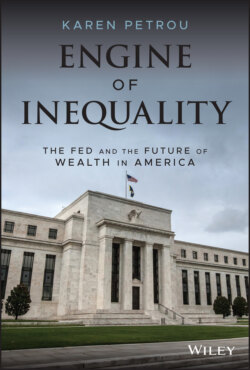Читать книгу Engine of Inequality - Karen Petrou - Страница 19
Who Has How Much
ОглавлениеUnsurprisingly, economists have many ways to study income, wealth, distribution, and even how many households or individuals should be counted.10 Still, I've found no objective, time-tested data to suggest that the United States is anything like the equality powerhouse President Trump asserted.
First to income and some hard numbers that make inequality all too real. One could of course assess the US in COVID's wake to make a strong inequality argument, but this might be countered by those saying it's unfair to take a snapshot of the US at the worst of times. So let's look instead at the end of 2019, the best of times since 2010. This is compelling evidence that Mr. Trump was wrong and the need to repair the inequality engine is urgent.
According to the Fed,11 26 percent of adults in 2019 had a family income of less than $25,000, which was just about the federal poverty level for a family of four in the contiguous US. Another 10 percent had a family income above $25,000 but below $40,000. Thus, more than one-third of Americans had family income below middle class as many define it.12
The top 20 percent had an average pretax income of $234,000 in 2018 (the most recent data available).13 Even in this group, income is segmented – the top 5 percent had pretax incomes exceeding $416,000 on average in 2018.14 At the same time, the bottom 20 percent made an average of $13,77515 and as a whole earned only 3.1 percent of US pretax income.16 Working-age adults in the bottom 50 percent group earned no more in 2014 than they did in real terms in 1980.17 By contrast, the average income for the top 1 percent rose more than 200 percent between 1980 and 2014 to more than $1.3 million.18 Put another way, the average earnings differential between the top 1 percent and bottom 50 percent was 27 times in 1980 but rose to 81 times in 2014.19
What of the vaunted American middle class? Using the “Gini coefficient” – an established equality measure – the middle class disappears into a void left by far more wealth at the top and far less sliding down to the bottom. Simply put, a Gini index of zero means that everyone earns or owns the same amount of income or wealth – perfect equality; a Gini of one means that one person earns or owns it all. The Gini coefficient thus helps to tell us if America's long-cherished image as a nation of middle-class households is still true. Sadly, it isn't.20
The Gini coefficient and survey data used by the Congressional Budget Office (CBO) show that the middle class took home a smaller slice of the income pie – i.e., it was “hollowed out” – by large income gains at the very top of the income distribution and by the descent of many once middle-class earners into lower-income groups from 1979 to 2016.21 In 1970, middle-class families earned 62 percent of national income; in 2018, this was 43 percent.22 Over the same period, the upper-income share grew from 29 percent to 48 percent,23 and lower-income share fell from 10 percent to 9 percent.24
The Federal Reserve Bank of Cleveland in 2020 looked at all of the most recent studies of the US middle class,25 comparing the 2018 middle class to the far more vibrant one in the US of 1980 before inequality began to accelerate. Looking at real median household income for working-age adults and recalculating it to reflect higher consumption costs, this study corrects for problems such as US demographic shifts and oversimplified income measures that do not reflect recent hikes in the cost of living. It finds “fairly flat” real income growth for the working-age middle class as a whole, but much of this is due to the growth of two-income households and all of it is eviscerated when the cost of health care and housing are taken into account. These costs increased more than nominal middle-class income from 1980 to 2018, with the cost of education alone over this period increasing an astonishing 600 percent.
